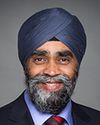Madam Chair, as this is the first time I am formally addressing the House, I would like to thank the residents of Davenport for placing their trust in me once again and electing me for the second time.
I am pleased to rise in the House this evening to speak about the ways National Defence and the Canadian Armed Forces are partnering with Canadians to enhance our national security. Together they are developing innovative tools and strategies and facilitating economic opportunity, while ensuring that our military can remain agile and adapt to a constantly changing and often unpredictable security environment.
It is no secret that Canada is facing threats in new and emerging domains. Global instability is heightened by the effects of climate change and scarcity, while rapid advances in technologies bring both opportunity and risk. Unlike the Conservatives, who cut billions of dollars in defence spending and mismanaged procurement projects, our defence policy, entitled “Strong, Secure, Engaged”, invests in our women and men in uniform and looks to tackle the challenges that a modern world faces.
Canada is looking at historically non-military threats through a military lens. Let us take cyber-domain as an example. As cyber-technologies continue to become a part of our everyday lives, Canada's responses must become increasingly nimble and nuanced to ensure we meet the new challenges they create. As a result of these and other emerging factors, National Defence is increasingly looking beyond the traditional defence and security sphere for input and for solutions, a whole-of-Canada approach to conducting defence.
Two years ago, the Minister of National Defence committed that the Department of National Defence would strengthen our relationship with the academic and expert community. We are doing exactly that through our new mobilizing insights in defence and security program, also known as MINDS. This program allows National Defence to reach out and mobilize the defence and security academic and expert community across Canada to gain expert insight on global security policy and to generate knowledge in the public policy realm. These measures also allow us to better anticipate and understand threats, opportunities and challenges that Canada will face. The MINDS program has recently launched three collaborative networks, bringing together multidisciplinary experts to address key defence and security challenges.
The department is reaching out even further with the innovation for defence excellence and security program, also known as IDEaS. Through this program, National Defence is supporting defence innovation across Canada, because we know that the federal government does not have a monopoly on good ideas. That is why, through IDEaS, we are reaching out to Canadian companies and innovators so they can put forward their best solutions to help us solve defence and security challenges. The IDEaS program was launched in April 2018 and, through it, challenges have been posted for the Canadian innovation community. The various elements of IDEaS include competitive projects, contests, innovation networks, sandboxes and innovation assessment and implementation.
Being able to adapt quickly to changing threats is one of the main goals of National Defence. This program will help bring forward the best ideas in each of these areas to help better support our women and men in uniform. It does not matter if someone is working from home, in a university lab or in a small company or large corporation; everyone is invited to participate in the IDEaS program.
The department has launched five calls for proposals under competitive projects, encompassing a total of 40 separate challenges. These calls for proposals cover a variety of existing and emerging defence and security challenges, from supporting Canadian Armed Forces members' physical and mental well-being, to enhancing Canada's cybersecurity, to finding ways to green defence, to all other ways the Canadian Armed Forces can be more nimble, more effective, more sustainable and more responsive to Canada's defence needs in the 21st century.
IDEaS also presents opportunities for innovators to field-test their projects in a realistic setting. This happened earlier this year at CFB Suffield, where participants had the opportunity to test their prototype solutions for detecting and countering micro- and mini-unmanned aerial systems in a real-world setting.
Finally, through IDEaS, the department is also running a variety of independent contests like the Pop-Up City challenge. Through this challenge, competitors are working with the Department of National Defence to develop improved energy, water, and waste management solutions through relocatable temporary camps that the military could one day use domestically or on deployments around the world.
Although these challenges are centred on defence, we know that innovation sparks further innovation. Canadian innovators are encouraged to workshop their ideas in a defence setting, but their work could also have applications across many other domains, just as the camera in our smart phones was originally designed to be small enough to sit on a spacecraft while still producing imagery of scientific quality.
Taken together, the IDEaS and MINDS programs demonstrate National Defence's dedication to inspiring innovation and to learning from new perspectives on defence and security.
We are also focused on ensuring that the Canadian Armed Forces receives the capabilities it needs now and in the future, one that takes into account our diversity. That is why our defence team completes a gender-based analysis plus as part of all defence team activities, making sure that our policies and our equipment support those who serve, no matter what their gender.
At the same time, when we invest in our capabilities, it helps build up the Canadian economy, creating well-paying middle class jobs for Canadians from coast to coast to coast.
As members can see, National Defence is working hard to provide the Canadian Armed Forces with the capabilities they need to stay agile and effective.
While the Conservatives spent a decade underinvesting in our Royal Canadian Air Force, our government is stepping up to ensure that we can meet our NORAD and NATO commitments at the same time.
National Defence is making progress on the competition for Canada's future fighter for the Royal Canadian Air Force, the largest investment in the Royal Canadian Air Force in over 30 years.
By investing in 88 future fighters, Canada will have the advanced capabilities it needs to remain a dedicated international partner around the world. Through this process, National Defence will work with suppliers and other stakeholders to support industrial and technological growth across Canada.
In the meantime, National Defence is exploring ways to extend the lifespan of our CF-18 fighters until this procurement is complete. Phase one of the Hornet extension project is already under way. It will deliver enhancements designed to meet international regulatory requirements and improve interoperability. In the coming years, this project will also deliver key improvements to the CF-18's combat capabilities by enhancing sensors, weapons, survivability, and mission support systems. Throughout this project, in-service support will be conducted through existing contracts with Canadian industry, creating additional opportunities for the people who build and maintain Canada's fighter jets.
Likewise, the department is continuing to make progress on the new Canadian surface combatant for the Royal Canadian Navy. Construction is scheduled to begin in the early 2020s. These warships will provide improved combat power at sea and facilitate missions such as counterpiracy, counterterrorism, humanitarian aid and search and rescue. They have started work on the armoured combat support vehicle project. This means they can begin to replace Canada's current fleet of LAV II Bison and M113 tracked LAV fleets as early as 2021, ultimately saving money that would otherwise be spent maintaining an aging fleet.
Because the combat support vehicles are being built here in Canada, this project is estimated to support over 10,000 jobs across the country. That is intentional. National Defence's capital projects have a significant impact on Canada's economy, providing jobs and opportunities across different industries. We see that in projects like the Arctic and offshore patrol ships as well.
Last month, the minister was able to visit the future HMCS Harry DeWolf just as it began the builder's sea trials, a major milestone. As a result of the hard work of shipbuilders and suppliers across the country, these will be the first Canadian-made ships in 20 years.
There is also the fixed-wing search and rescue aircraft replacement project. We expect this plane to arrive in Comox this spring, enhancing the Canadian Armed Forces' vital search and rescue capabilities, including in Canada's north.
These projects demonstrate the ways that National Defence and the Canadian Armed Forces are driving innovation and creating jobs for Canadians, ensuring Canada remains a valued international partner while also supporting Canada's economy.
Whether we are talking about programs like IDEaS and MINDS or some of the largest procurement projects in the department's history, National Defence is making sure our military is ready for tomorrow's challenges, challenges that increasingly operate beyond a military context.







